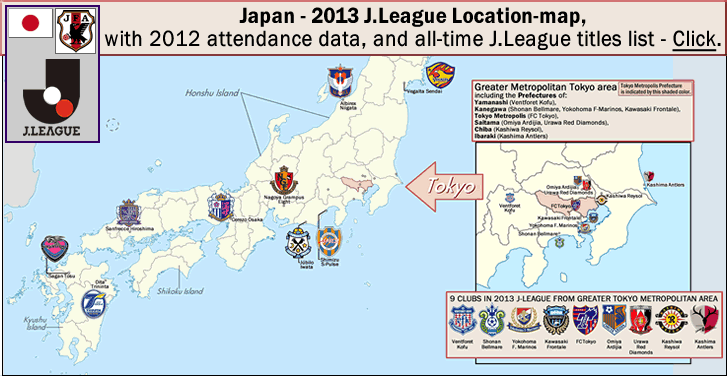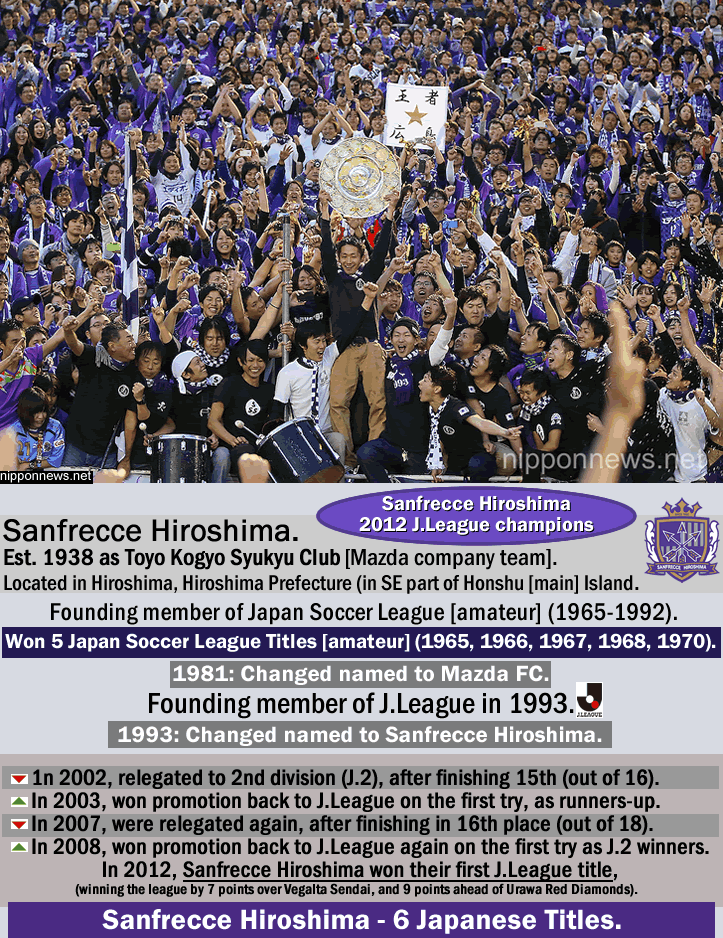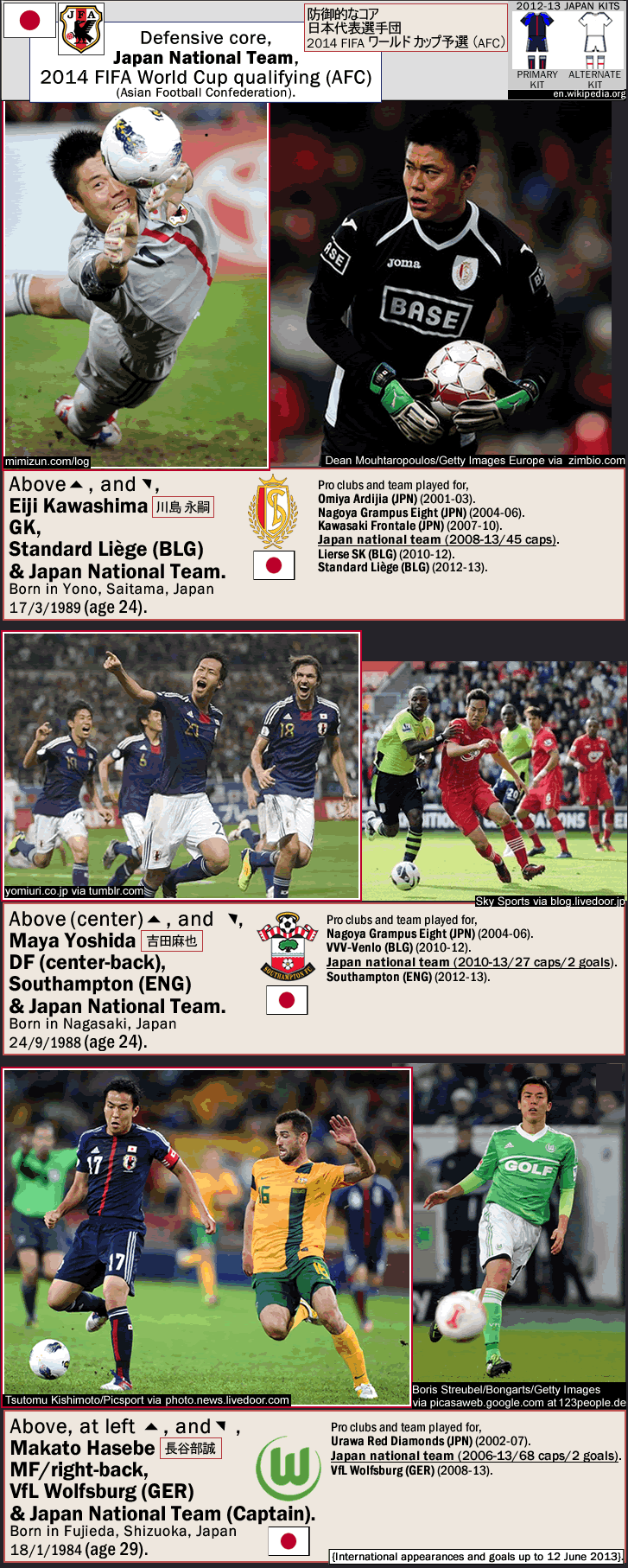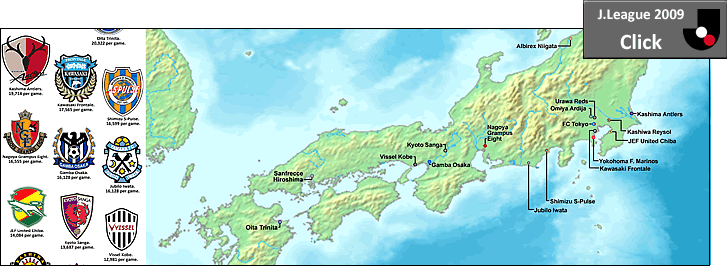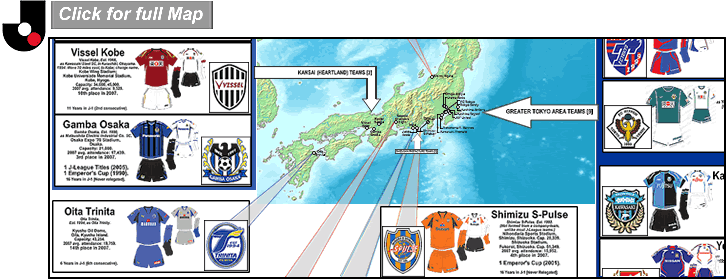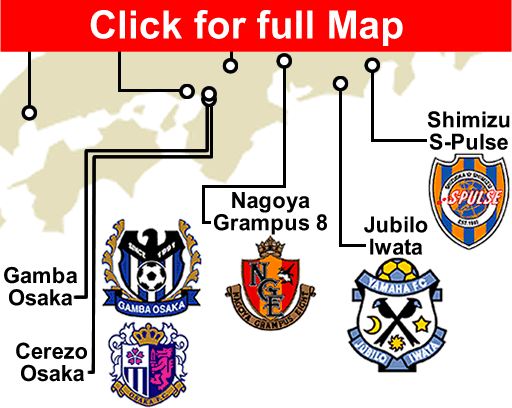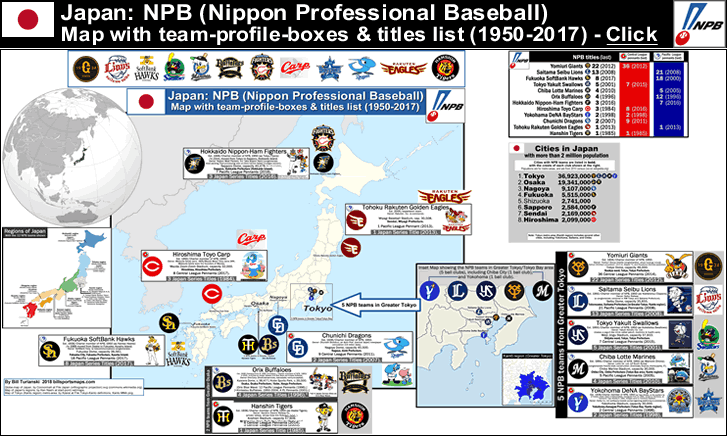
Japan: NPB (Nippon Professional Baseball), 2018 – location map, with profile-boxes of the 12 teams, and NPB titles list (1950-2017)
…
…
By Bill Turianski on 25 April 2018; twitter.com/billsportsmaps.
Links…
-Nippon Professional Baseball (en.wikipedia.org).
-reddit.com/r/NPB.
-Official website…npb.jp/eng/teams.
公式サイト…npb.jp.
The map-page…
The map-page features a location-map of the 12 NPB teams in Japan, with team profile-boxes overlaid. The main map is augmented by an inset-map of Greater Tokyo (at the lower-left of the map-page). At the upper-left of the map-page is a globe-map showing Japan’s location in East Asia. Below that, at the far left, is a small multi-color map of Japan, showing the country’s regions within the four primary islands (plus Okinawa) which comprise Japan, as well as NPB representation within those regions. At the upper-right of the map-page is a chart showing NPB titles by team (1950-2017), as well as Central League-/-Pacific League titles won by each team (see: Rules in NPB and league format section 4 paragraphs below for more on that). Below that is a small chart showing NPB representation in Japanese cities (the 8 cities in Japan with a population of more than 2 million in their metro-areas).
The team-profile-boxes feature basic info on the teams, including primary-cap-logo, location and venue, ownership, and titles, plus team mascots. Secondary logos are next to each team’s profile-box.
…
Demographics of Japan…
The population of Japan is around 126.6 million {source: 2017 estimate, here at Japan en.wikipedia page}. This puts Japan as the 10th-most-populous nation on Earth. Japan is not very large in terms of land area, though: it is the 61st-largest country, at 377,972 km-squared (145,936 sq mi). That makes Japan slightly smaller than the US state of Montana, and slightly larger than the nation of Germany. The largest city in Japan (by far) is, of course, Tokyo…which is absolutely gigantic, and has a metro-area population that is the largest on the planet (at ~37.8 million). {Source.} Basically, 30% of the population of Japan resides in Tokyo’s metropolitan area. [Note: again, on the map-page, there is a list of the largest cities in Japan.] Japan has about the 28th-highest adjusted-GDP in the world {see this, List of countries by GDP (PPP) per capita).
…
Nippon Professional Baseball was formed in 1950.
The set-up consisted of 12 teams, with 6 teams in the Central League, and 6 teams in the Pacific League. Like Major League Baseball back then, the teams in one league did not play teams in the other league during the regular season. This 12 team / 2 league format remains to this day. The Japanese mimicry of Major League Baseball’s format continued, when, in 1975, one league – the Pacific League – adopted the Designated Hitter rule (this was 2 years after MLB’s American League instituted the DH rule, while the National League did not). Nippon Professional Baseball continued to take its cues from Major League Baseball when inter-league play between the Central League and the Pacific League was introduced in 2005 (8 years after inter-league play was intstituted in Major League Baseball).
Rules in NPB and league format:
The rules in NPB are the same as in MLB, except with tie games going into extra innings…after 12 innings, the game is declared a tie (a draw) in the standings, except in the post-season, when tied games after 15th innings are abandoned, and then later re-played.
The 2 leagues both play 144-game regular seasons. Unlike in MLB, in Japan, the pennant-winner is crowned before the playoffs begin… the teams with the best regular season records in the two leagues are the Central League Pennant winner and the Pacific League Pennant winner. (In other words, unlike in MLB’s World Series, in Japan, the teams that meet to decide the NPB title in the Japan Series are not necessarily pennant winners.) The top 3 teams in each league make the playoffs. The pennant-winners (again, first place team from the regular season), gets a bye to the second round; while the 2nd-place and 3rd-place finishers play in the First Stage (a 3-game-series). Then the First Stage winners play the Pennant winners in the Second Stage (a 5-game-series). Those two playoff-winners then play for the title, in the Japan Series (a 7-game-series).
Distribution of NPB teams throughout Japan…
While it is true that Japanese baseball franchises do sometimes move, that is part of a broader trend of teams simply going to areas that had been historically ignored by Nippon Professional Baseball. Because as recently as 1988, 30 years ago, 9 of the 12 NPB teams used to be located in just two regions – the Greater Tokyo Bay area [the Kanto region], which previously had 6 teams (5 teams are located there now), and the central Japan/Osaka/Kobe area, which previously had 3 teams (2 teams are located there now). Since then, franchises have moved to Kysuhu Island (where the Fukuoka SoftBank Hawks [est. 1989] are located), and Hokkaido Island (where the Hokkaido Nippon-Ham Fighters [est. 2004] are located. The Osaka region lost its 3rd team when the Orix BlueWave merged with the Kintetsu Buffaloes. And then when the only-ever players’ strike in NPB (in the late summer of 2004) forced the league to reverse their decision to contract to 11 teams in 2005, the new franchise (the Tohoku Rakuten Golden Eagles) was not re-placed in the Osaka region, but instead put in the Sendai region north of Tokyo. There is one area that has never had an NPB team, and that would probably support one pretty well – the NW Honshu Island (main island) city of Niigata, which is on the west coast on the Sea of Japan. Niigata (population of around .8 million) is home to one of the highest-drawing J-League soccer teams in Japan – Albirex Niigata, who became the first-ever J-League team to average over 40,000 per game, in 2005.
Foreign player restrictions:
4 foreign players on the 25-man active roster allowed, with no organizational limit.
Minor leagues in Japan:
Each NPB team has 1 minor league team in its organization, and most of the minor league teams use the name and uniforms of their parent-club, and the minor league team also plays in the same area as their parent-club (exception – in location: Hokkaido’s minor league team is still located in the Tokyo Bay area).
Japanese-born players in Major League Baseball
Up to the 2018 season, a total of 55 Japanese-born players have played at least 1 game in Major League Baseball. {Source: List of Major League Baseball players from Japan.} The biggest restriction is the 9-year rule, disallowing any NPB player without 9 years’ tenure with a NPB team’s organization, and along with that, another impediment is the ‘Posting’ system {see this: en.wikipedia.org/[Posting system]}.
Current [2018] Japanese-born players in MLB…
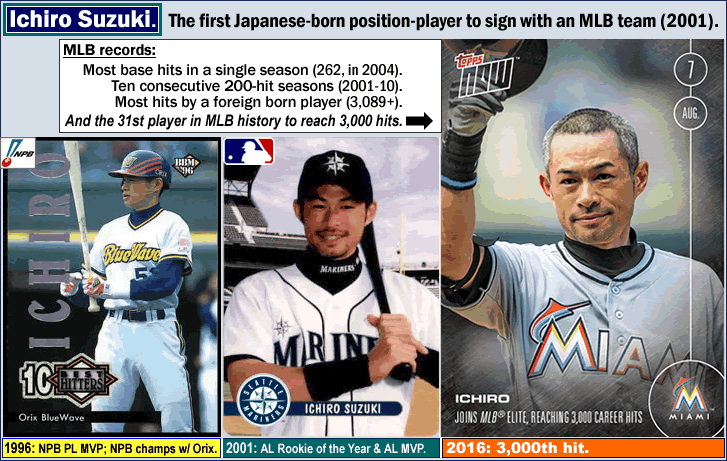
Photo credits above – 1996 BBM Ichiro card, from ebay.com. 2001 [Mariners/Keebler stadium-giveaway-item] Ichiro card, from ebay.com. 2001 Topps Ichiro card, from topps.com.
Ichiro Suzuki, Seattle Mariners OF (age 44). Once he finally retires, Ichiro will become the first Japanese-born player to be elected to the Baseball Hall of Fame, and he will probably be elected on the first ballot. After all, he is one of the 31 players in all of Major League Baseball history that is in The 3,000 hits club [and there has never been any allegations of doping/steroid abuse wrt Ichiro]. Ichiro, who prefers to be referred to by his first name, played in NPB for 9 seasons with the Orix Blue Wave (1992-2000), where he was a 7-time All-Star (1994–2000), a 3-time Pacific League MVP (1994–1996), and was part of the 1996 Orix Blue Wave team that were NPB champions (see 1996 trading card above). Ichiro was signed by the Seattle Mariners in Nov. 2000, becoming the first Japanese-born position player to sign for an MLB team. In the following year of 2001, amid heavy coverage by both Japanese and North American media, Ichiro was the first player to lead in Batting Average and Stolen Bases (.350/56), since Jackie Robinson did it in 1949. And he became only the second player to win the AL Rookie of the Year award and the AL MVP award (the first was Boston’s Fred Lynn in 1975). Ichiro played 11-and-a-half seasons for Seattle (2001-12), then played 2-and-a-half seasons for the New York Yankees (2012-14), then played 3 seasons for the Miami Marlins (2015-17). He returned to the Seattle Mariners in 2018, as a 44-year-old. Excerpts from the Ichiro Suzuki page at en.wikipedia.org…”Ichiro has established a number of batting records, including MLB’s single-season record for hits with 262. He achieved 10 consecutive 200-hit seasons, the longest streak by any player in history. Between his major league career in both Japan and the United States, Ichiro has the most hits by any player in top-tier professional leagues…In his combined playing time in NPB and MLB, Ichiro has received 17 consecutive selections both as an All-Star and Gold Glove winner, won nine league batting titles and been named MVP four times…He is also noted for his longevity, continuing to produce at a high level while approaching 43 years of age…In total he has over [4,450] hits in his career.”…{Excerpts from en.wikipedia.org/wiki/Ichiro_Suzuki.}
Junichi Tazawa, Miami Marlins Relief Pitcher (RHP) (age 31). Tazawa never played in NPB. He was un-drafted out of high school, and so he played for the company team of Nippon Oil in the corporate league [unaffiliated with NPB], and was MVP in that company-league’s post-season in 2008. It was then, circa late-2008/early-2009 that Tazawa became the first amateur Japanese ballplayer to shun the NPB, and sign with an MLB team (the Boston Red Sox) {see this article from 2008 from ESPN.com, Amateur Tazawa bypassing Japan leagues for MLB}. Tazawa worked middle relief for the Red Sox for 7 seasons (2009; 2011-16), and was part of the Boston Red Sox 2013 World Series championship team, making 13 appearances in the 2013 post-season including 5 appearances in the World Series that year, with these post-season stats: 13 app/1-0/1.38 ERA/7.1 IP. Tazawa has been a middle reliever for the Marlins since 2017.
Yu Darvish, Chicago Cubs Starting Pitcher (RHP) (age 31). Played in NPB for the Hokkaido Nippon-Ham Fighters (2005–2011); posted by the Hokkaido Nippon-Ham Fighters and signed with the Texas Rangers in Jan. 2012. Yu Darvish is the son of an Iranian-born father and a Japanese mother. In NPB, Darvish was a two-time Pacific League MVP (2009, 2011), a 5-time NPB All-Star (2007–2011), and led the Pacific League in Strikeouts 3 times and in ERA twice. Darvish was a member of the 2006 NPB champions the Hokkaido Nippon-Ham Fighters. In MLB, playing for the Texas Rangers, the Los Angeles Dodgers, and now the Chicago Cubs, Darvish has an overall 18.3 WAR, going 56-44 (3.50 ERA) [as of 24 April 2018]. Darvish’s best season in MLB was in 2013, when he went 13-9 (2.84 ERA) and led the majors in Strikeouts (277, with 80 Walks). Darvish has been a 4-time All-Star (2012–2014, 2017). But Darvish had a bad World Series with the LA Dodgers in 2017, getting bombed in both appearances, going 0-2 with a 21.60 ERA (when the Dodgers lost to the Houston Astros in 7 games). Darvish’s problems continued on into 2018, where he is [as of 24 April 2018] 0-2 (6.86 ERA) for the Cubs.
Masahiro Tanaka, New York Yankees Starting Pitcher (RHP) (age 29). Played in NPB for the Tohoku Rakuten Golden Eagles (2007–2013); posted by the Tohoku Rakuten Golden Eagles and signed with the New York Yankees in Jan. 2014. Was 6-time NPB All-Star (2007–2009, 2011–2013), and led NPB in ERA twice (2011, 2013); plus Tanaka was a member of the 2013 NPB champions (the Tohoku Rakuten Golden Eagles). Tanaka has been a vital part of the Yankees’ rotation since 2014, with an overall 12.6 WAR, going 55-30 (3.63 ERA) [as of 24 April 2018]. In 2014, Tanaka went 13-5 (2.77 ERA) for the Yankees and was a 2014 All-Star, but injuries kept him from playing most of the second-half of 2014. In 2016, Tanaka went 14-4 (3.04 ERA), with the best WAR for the Yankees that year, at 5.2.
Kenta Maeda, Los Angeles Dodgers. Starting Pitcher (RHP) (age 30). Played in NPB for the Hiroshima Toyo Carp (2008–2015); posted by Hiroshima Toyo Carp and signed with the Los Angeles Dodgers in Jan. 2016. Was a 5-time NPB All-Star (2010, 2012–2015). For the Dodgers, Maeda has been a solid starter, going 16-11 (3.48 ERA) in 2016, and 13-6 (4.22 ERA) in 2017.
Yoshahisa Hirano, Arizona Diamondbacks. Relief Pitcher (RHP) (age 34). Played in NPB for 11 seasons with the Orix Buffaloes (2006-07; 2009-17). Hirano had more than the requisite 9 years tenure in NPB, so he didn’t have to be posted. Hirano signed with the Arizona Diamondbacks in Dec. 2017. Was the NPB Middle Reliever of the Year in 2011, and Saves leader in the 2014 Pacific League. So far, Hirano has fit in very well in MLB with Arizona, and [as of 24 April 2018] he has made 11 appearances in middle relief, with a 1-0 record and a 1.74 ERA for the division-leading D-backs.
Kazihisa Makita, San Diego Padres. Relief Pitcher (RHP) (age 33). Played in NPB for the Seibu Lions (2011-17); posted by Seibu Lions and signed by the San Diego Padres in Dec. 2017. Makita has a sidewinder (or submarine) delivery. Was Pacific League Rookie of the Year in 2011, and an NPB All-Star in 2011 and 2013. For the Padres, [as of 24 April 2018] he has 11 appearances in middle relief, with a 4.50 ERA.
Shohei Ohtani, Los Angeles Angels. Starting Pitcher (RHP) and DH/OF (Bats Left) (age 23). Played in NPB for the Hokkaido Nippon-Ham Fighters (2013–17). Was posted by Hokkaido Nippon-Ham Fighters, and was signed by the Los Angeles Angels in Dec. 2017. Ohtani is a dual-threat player who can pitch with speed and finesse AND who can hit for power and for average. Ohtani proved it in Japan, and right now, so far, he is proving he can do it in Major League Baseball. Ohtani was part of the 2016 NPB champions (the Hokkaido Nippon-Ham Fighters). As a starting pitcher in NPB, Ohtani had the Pacific League’s best ERA in 2015, and he was voted to the NPB Best Nine as a Pitcher in 2015 and 2016, as well as being voted to the NPB Best Nine as DH in 2016. Which is absolutely unprecedented. Ohtani recalls the pitching-and-slugging skills once displayed by no less than Babe Ruth himself, back in the 1910s and 1920s (Babe Ruth, for the Boston Red Sox in 1919, hit 20 HRs and pitched for a 9-5 record with an ERA of 2.97 in 133 IP). Ohtani’s current MLB numbers: [as of 24 April 2018] 3 HR, 1 Triple, 1 Double and 11 RBIs in 42 AB (a .333 BAvg and a .619 SPct) plus a 2-1 pitching record (4.46 ERA) in 4 GS and 20.1 IP. Ohtani appears to be the real deal, and along with Mike Trout, could very well lead the division-leading Angels to post-season glory soon. {From Deadspin, from the 25th of April, Shohei Ohtani Threw The Ball Hard As F*ck (by Tom Ley at deadspin.com).}
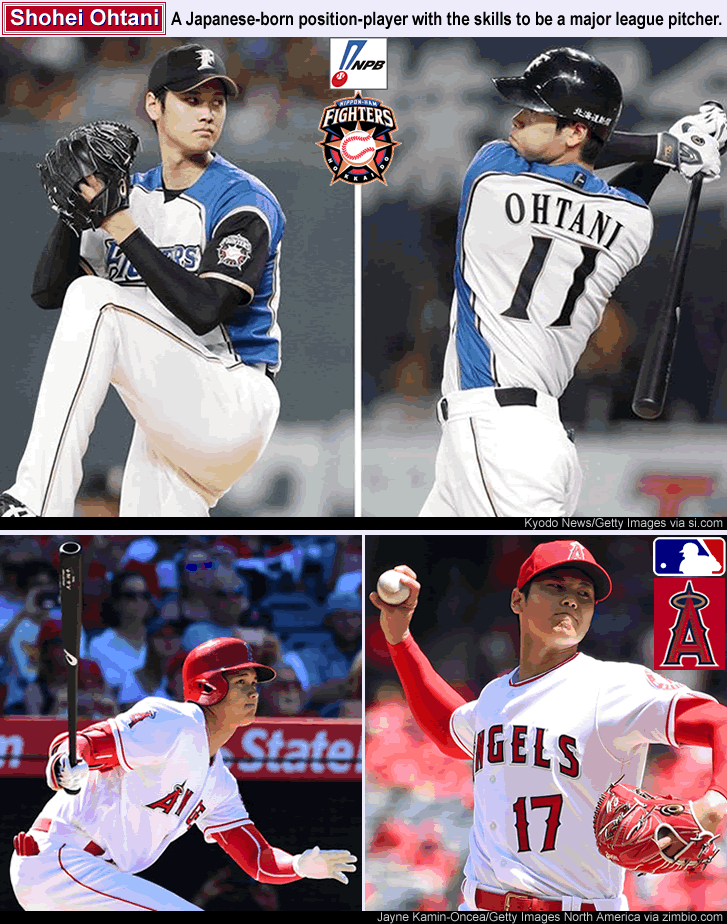
Photo credits above – Ohtani as pitcher and as batter for Hokkaido, 2 photos by Kyodo News/Getty Images via si.com. Ohtani batting for LA Angels, and Ohtani pitching for LA Angels, 2 photos by Jayne Kamin-Oncea/Getty Images North America via zimbio.com.
…
2017 Japan Series: Fukuoka SoftBank Hawks beat Yokohoma DeNa BayStars, 4 games to 2. (Fourth NPB title in 7 seasons for Fukuoka.)

Photo and Image credits above – Dennis Sarfate, photo by Kyodo News via gettyimages.com. Keizo Kawashima, photo by Kyodo News via japantimes.co.jp. Nao Higashihama, photo by Kyodo News via gettyimages.com. Yuki Yanagita, photo by Kyodo News via gettyimages.com.
Alfredo Despaigne, photo by Gaffkey at File:Hawks54-Despaigne.jpg (commons.wikimedia.org).
Fukuoka at twilight, photo by Alamy via theguardian.com/travel/flourishing-fukuoka…. Fukuoka Dome, photo unattributed at blog.gaijinpot.com/fukuokas-seaside-momochi. The Fukuoka Hawks’ balloon-release (a 7th inning tradition at Fukuoka Dome), photo by Brad Merrett at bradmerrett.com/blog/go-hawks. Mascots: photos from softbankhawks.co.jp.
___
Thanks to all at the following links…
-Blank map of Japan, by Maximilian Dörrbecker (Chumwa) at File:Japan location map.svg (commons.wikimedia.org).
-Globe-map of Japan, by Connormah at File:Japan (orthographic projection).svg (commons.wikimedia.org).
-Map of Japan’s regions, by Ken Nashi at start-point.net/maps.
-Map of Tokyo (Kantō MMA) metro-area, by Kzaral at File:Tokyo-Kanto definitions, Kanto MMA.png.
-worldatlas.com/articles/10-biggest-cities-in-japan.
-Seibu Lions mascot/photo from store.seibulions.jp.
-Chiba Lotte Marines new mascot (Mystery Fish), image from palusuke.com.
-Hiroshima Toyo Carp mascot (Slyly), illustration from seiga.nicovideo.jp.
-Thanks to MeGaNiNjA (スピードさん) @MegaNiNj4, for requesting this map (via twitter), and for helping me find mascot illustrations.
-Thanks to the guy who runs the twitter feed for the Reddit/NPB page, for finding mistakes, on my map here (twitter.com/NPB_Reddit).







